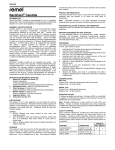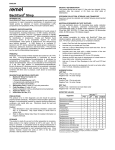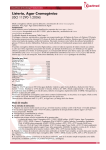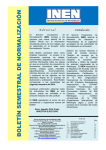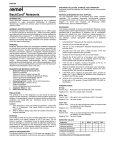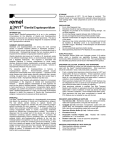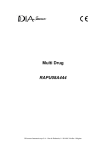Download BactiCard E. coli - Thermo Scientific
Transcript
ENGLISH BactiCard® E. coli INTENDED USE ® Remel BactiCard E. coli is a test kit recommended for use in qualitative procedures for rapid, presumptive identification of Escherichia coli. SUMMARY AND EXPLANATION E. coli is the most commonly recovered bacterial species in the clinical laboratory with disease processes ranging from urinary tract 1 infections to gram-negative sepsis. In 1981, Godsey et al. found 4methylumbelliferyl-β-D-glucuronide (MUG) a sensitive and selective substrate for detection of β-glucuronidase activity which is present in 2 most E. coli (97%). Trepeta and Edberg used the MUG test in conjunction with oxidase, indole, and lactose fermentation as a 3 method for rapid, cost-effective identification of E. coli. PRINCIPLE ® BactiCard E. coli consists of two separate test circles for MUG and indole (IND). In the presence of the enzyme β-glucuronidase, 4-methylumbelliferone is released from the substrate, 4-methylumbelliferyl-β-Dglucuronide. This compound (4-methylumbelliferone) is highly fluorescent and can be detected by longwave ultraviolet light. In the indole test, tryptophan and ρ-dimethylaminobenzaldehyde serve as substrates for detection of the enzyme, tryptophanase. This enzyme attacks the tryptophan molecule producing indole which reacts with ρdimethylaminobenzaldehyde to produce a red color. REAGENTS AND MATERIALS SUPPLIED ® 1. BactiCard E. coli Test Cards (25) Reactive Ingredients: 4-Methylumbelliferyl-β-D-glucuronide Tryptophan and ρ-Dimethylaminobenzaldehyde 2. Rehydrating Fluid (1 bottle, 6.0 ml) with preservative 3. MUG Reagent (1 bottle, 6.0 ml) 4% Sodium Hydroxide 4. Applicator Sticks (1 vial) 5. Instructions for Use (IFU) PRECAUTIONS This product is for In Vitro diagnostic use and should be used by properly trained individuals. Precautions should be taken against the dangers of microbiological hazards by properly sterilizing specimens, containers, and media after use. Directions should be read and followed carefully. Caution! 1. MUG Reagent may cause irritation to skin, eyes, and respiratory system. 2. Refer to Material Safety Data Sheet for detailed information on reagent chemicals. STORAGE This product is ready for use and no further preparation is necessary. Store product in its original container at 2-8°C until used. Do not freeze or overheat. Allow product to equilibrate to room temperature before use. Do not incubate prior to use. Once opened, maintain unused test cards at 2-8°C in the foil pouch provided. Seal to protect from moisture. PRODUCT DETERIORATION This product should not be used if (1) the color has changed, (2) the expiration date has passed, or (3) there are other signs of deterioration. SPECIMEN COLLECTION, STORAGE, AND TRANSPORT Specimens should be collected and handled following recommended 4 guidelines. MATERIALS REQUIRED BUT NOT SUPPLIED (1) Loop sterilization device, (2) Inoculating loop, swabs, collection containers, (3) Incubators, alternative environmental systems, (4) Supplemental media, (5) Quality control organisms, (6) Oxidase reagent, (7) Gram stain reagents, (8) Microscope slides, (9) Microscope, and (10) Longwave ultraviolet light (Woods Lamp). PROCEDURE ® Test isolates acceptable for testing with BactiCard E. coli are oxidase-negative, gram-negative bacilli. Remove test isolates from pure, 18-72 hour cultures growing on blood agar. 1. Label a Test Card with the specimen identification. 2. Inoculate only one isolate per Test Card. 3. Add one (1) drop of Rehydrating Fluid to the MUG test circle, only. Do not oversaturate the test area. 4. Inoculate each test circle with a visible inoculum of the test isolate using an applicator stick (provided). 5. Incubate at room temperature (RT) for 15 minutes. 6. Observe the IND test circle for development of a red color, indicating a positive test. 7. Add one (1) drop of MUG Reagent to the MUG test circle. 8. Observe the MUG test circle in a darkened room with a longwave ultraviolet light for bright-blue fluorescence, indicating a positive test. INTERPRETATION Indole Test: Positive Test - Color change to red Negative Test - No color change MUG Test: Positive Test - Bright blue fluorescence Negative Test - No fluorescence EXPECTED VALUES Organism Indole MUG Escherichia coli Shigella Gp A, B, C Shigella sonnei Klebsiella pneumoniae Klebsiella oxytoca Enterobacter Serratia marcescens Yersinia Salmonella Citrobacter freundii Citrobacter koseri + V – – + – V V – – + + – – – – – – – – – – Oxidase Lactose – – – – – – – – – – – + – – + + + – – b – V V a +, most strains positive; –, most strains negative; V, variable a Most strains of E. coli O157:H7 are MUG-negative.5 b Rare lactose-positive strains occur.4 QUALITY CONTROL ® All lot numbers of BactiCard E. coli have been tested using the following quality control organisms and have been found to be acceptable. Testing of control organisms should be performed in accordance with established laboratory procedures. If aberrant quality control results are noted, patient results should not be reported. CONTROL Escherichia coli ® ATCC 25922 Klebsiella pneumoniae ® ATCC 27736 INCUBATION RESULTS IND MUG Aerobic, 15 min. @ RT + + Aerobic, 15 min. @ RT – – ENGLISH PERFORMANCE CHARACTERISTICS ® Remel BactiCard E. coli was evaluated with 243 strains of gramnegative bacilli representing 15 genera and showed greater than 98% agreement with expected values. 4. LIMITATIONS 1. This test is only part of the overall scheme for identification of E. coli. Additional testing may be required for definitive identification. 4 Consult appropriate references for further instructions. 2. Serological testing may be required to differentiate certain 1 closely related strains of E. coli and Shigella. 3. Most strains of E. coli O157:H7 are MUG-negative. Enterohemorrhagic E. coli is associated with bloody diarrhea and abdominal cramps. Complications may occur in the very young and elderly, including hemolytic uremic syndrome (HUS) and thrombotic thrombocytopenic purpura. Latex agglutination tests ® may be used in conjunction with BactiCard E. coli for rapid and 5 accurate detection of E. coli O157:H7. 4. False-negative MUG reactions may occur with inoculum 5 removed from MacConkey Agar or Triple Sugar Iron Agar. 5. Some strains of Salmonella, Shigella, Staphylococcus, and Streptococcus possess the enzyme β-glucuronidase and may produce a positive MUG test. A positive test for lactose fermentation can be used to rule out Salmonella and Shigella and 6 a Gram stain will differentiate gram-positive cocci from E. coli. PACKAGING ® REF R21108, BactiCard E. coli ........................................ 25 Tests/Kit BIBLIOGRAPHY 1. 2. 3. Winn, W., S. Allen, J. William, E. Koneman, G. Procop, P. Schreckenberger, and G. Woods. 2006. Koneman’s Color Atlas and Textbook of Diagnostic Microbiology. 6th ed. Lippincott Williams and Wilkins, Baltimore, MD. Godsey, J.H., M.R. Matteo, D. Shen, G. Tolman, and J.R. Gohlke. 1981. J. Clin. Microbiol. 13:483-490. Trepeta, R.W. and S.C. Edberg. 1984. J. Clin. Microbiol. 19:172-174. 5. 6. Murray, P.R., E.J. Baron, J.H. Jorgensen, M.L. Landry, and M.A. Pfaller. 2007. Manual of Clinical Microbiology. 9th ed. ASM Press, Washington, D.C. Raj, P. 1993. Clin. Microbiol. Newsl. 15:89-93. Kilian, M. and P. Bulow. 1976. Acta. Pathol. Microbiol. Scand. 84:245-251. Symbol Legend REF Catalog Number IVD In Vitro Diagnostic Medical Device LAB For Laboratory Use Consult Instructions for Use (IFU) Temperature Limitation (Storage Temp.) LOT Batch Code (Lot Number) Use By (Expiration Date) EC REP European Authorized Representative BactiCard® is a registered trademark of Remel Inc. ATCC® is a registered trademark of American Type Culture Collection IFU 21108, Revised April 20, 2009 12076 Santa Fe Drive, Lenexa, KS 66215, USA General Information: (800) 255-6730 Technical Services: (800) 447-3641 Order Entry: (800) 447-3635 Local/International Phone: (913) 888-0939 International Fax: (913) 895-4128 Website: www.remel.com Email: [email protected] Printed in U.S.A. FRENCH COLLECTE, STOCKAGE ET TRANSPORT DE PRÉLÈVEMENTS Les prélèvements doivent être collectés et manipulés conformément 4 aux recommandations en usage dans la profession. BactiCard® E. coli MATÉRIEL REQUIS NON FOURNI (1) Dispositif de stérilisation en boucle, (2) boucle à inoculation, porte-coton, récipients de collecte, (3) incubateurs, systèmes environnementaux alternatifs, (4) milieux supplémentaires, (5) organismes de contrôle de qualité, (6) réactif oxydase, (7) réactifs souche gram, (8) lamelles de microscope, (9) microscope et (10) lampe à UV à grande longueur d’onde (lampe de Woods). INDICATION ® Le kit de test BactiCard E. coli de Remel est recommandé dans le cadre des procédures qualitatives pour la détermination présomptive rapide de l’Escherichia coli. RÉSUMÉ ET EXPLICATION L’Escherichia coli est l’espèce bactérienne la plus commune en laboratoire clinique, associée à des processus dégénératifs allant de 1 l’infection des voies urinaires à la sepsie à gram négatif. En 1981, Godsey et d’autres ont découvert que le 4-méthyl-ombelliferyl-β-Dglucuronide (MUG) constituait un substrat sensible et sélectif pour la détection de l’activité de la β-glucuronidase presque toujours 2 présente dans l’E. coli (97 %). Trepeta et Edberg ont utilisé le test MUG en l’associant à la production d’oxydase et d’indole et à la fermentation de lactose pour obtenir une méthode rapide et peu 3 coûteuse de détermination de l’E. coli. PROCÉDURE ® Les isolats pouvant être testés à l’aide de la BactiCard E. coli sont les bacilles à Gram négatif et à oxydase négative. Prélever les isolats à tester sur des cultures pures de 18 à 72 heures sur gélose au sang. 1. Étiqueter une carte de test avec l'identifiant de l’échantillon. 2. Inoculer un seul isolat par carte de test. 3. Ajouter une (1) goutte de liquide de réhydratation sur le cercle de test MUG uniquement. Ne pas sursaturer la zone de test. 4. Inoculer chaque cercle de test avec un inoculum visible de l’isolat à tester à l’aide d’un bâtonnet applicateur (fourni). 5. Incuber pendant 15 minutes à température ambiante. 6. Si le cercle de test IND vire au rouge, le test est positif. 7. Ajouter une (1) goutte de réactif MUG sur le cercle de test MUG. 8. Dans une pièce noire, regarder si le cercle de test MUG présente une fluorescence bleu vif lorsqu’il est exposé à un rayonnement ultraviolet de grande longueur d'onde (UVA), cette fluorescence indiquant un test positif. PRINCIPE ® La BactiCard E. coli comporte deux cercles de test distincts pour le réactif MUG et l’indole (IND). En présence de l’enzyme β-glucuronidase, du 4-méthyle-umbelliférone est libéré par le substrat, le 4-méthyle-umbelliféryl-β-D-glucuronide. Ce composé (le 4-méthyleumbelliférone) est hautement fluorescent et peut être détecté par rayonnement ultraviolet de grande longueur d'onde (UVA). Lors du test de l’indole, le tryptophane et le ρ-diméthylaminobenzaldéhyde servent de substrats pour la détection d’une enzyme, la tryptophanase. Cette enzyme attaque la molécule de tryptophane ce qui entraîne la production d'indole ; l'indole réagit avec le ρ-diméthylaminobenzaldéhyde et produit une couleur rouge. INTERPRÉTATION Test INDOLE: Test Positif - La couleur vire au rouge Test Négatif - Pas de virage de couleur Test MUG : Test Positif - Fluorescence bleu vif Test Négatif - Pas de fluorescence RÉACTIFS ET MATÉRIEL FOURNIS 1. Cartes de test BactiCard E. coli (25) Ingrédients réactifs: 4-méthyl-ombelliferyl-β-D-glucuronide Tryptophane et ρ-diméthyl-amino-benzaldéhyde 2. Fluide réhydratant (1 flacon, 6,0 ml) avec conservateur 3. Réactif MUG (1 bouteille de 6,0 ml): hydroxyde de sodium à 4% 4. Bâtonnets applicateurs (1 flacon) 5. Mode d’emploi (IFU) PRÉCAUTIONS Ce produit exclusivement destiné à un usage diagnostique in vitro ne doit être utilisé que par des personnes dûment formées. Toutes les précautions contre les risques microbiologiques doivent être prises et il est indispensable de bien stériliser les prélèvements, les récipients et les milieux après usage. Toutes les instructions doivent être lues attentivement et scrupuleusement respectées. Attention ! 1. Le réactif MUG peut irriter la peau, les yeux et les voies respiratoires. 2. Se reporter aux fiches signalétiques pour les informations détaillées sur les réactifs chimiques. VALEURS ATTENDUES OrganismOrganisme Escherichia coli Indole + MUG a + Shigella groupe A, B, C V – – Shigella sonnei – – – – Klebsiella pneumoniae – – – + Klebsiella oxytoca + – – + Enterobacter – – – + Serratia marcescens V – – – Yersinia V – – – Salmonella – – – – Oxydase Lactose – + – b Citrobacter freundii – – – V Citrobacter koseri + – – V +, majorité de souches positives ; –, majorité de souches négatives ; V, variable a La plupart des souches d’E. coli O157:H7 sont négatives au test MUG.5 b De rares souches sont positives au lactose.4 CONTRÔLE DE QUALITÉ ® Tous les numéros de lots du kit BactiCard E. coli ont été testés avec les organismes de contrôle de qualité suivants et reconnus acceptables. Les tests des organismes de contrôle effectués doivent satisfaire aux critères établis pour les procédures de contrôle de qualité en laboratoire. En cas de résultats de contrôle de qualité aberrants, les données patient de doivent pas être enregistrées. STOCKAGE Le produit est prêt à l’emploi et aucune préparation supplémentaire n’est nécessaire. Il doit être stocké dans son flacon d’origine et conservé à une température comprise entre 2 et 8 °C jusqu’à son utilisation. Ne pas congeler ni surchauffer. Attendre que le produit soit à température ambiante avant de l’utiliser. Ne pas incuber avant utilisation. Après ouverture, maintenir les cartes de test non utilisées à une température comprise entre 2 et 8 °C dans le sachet métallisé fourni. Sceller pour protéger de l’humidité. CONTRÔLE Escherichia coli ® ATCC 25922 Klebsiella pneumoniae ® ATCC 27736 DÉTÉRIORATION DU PRODUIT Ce produit ne doit pas être utilisé si (1) la couleur a changé, (2) la date de péremption est dépassée ou (3) d’autres signes de détérioration sont présents. 3 INCUBATION Aérobie, 15 minutes à température ambiante Aérobie, 15 minutes à température ambiante RESULTAS IND MUG + + – – FRENCH PERFORMANCES ® Le kit de test Remel BactiCard E. coli a été évalué avec 243 souches de bacilles à gram négatif représentant 15 genres et dans plus de 98 % des cas, les résultats ont été conformes aux valeurs attendues. LIMITATIONS 1. Il ne s'agit là que d'un test faisant partie d'un ensemble de méthodes d’identification d’E. coli. Des tests supplémentaires peuvent s’avérer nécessaires pour confirmer l'identification. Consulter les références bibliographiques correspondantes pour 4 obtenir de plus amples instructions. 2. Des tests sérologiques peuvent être nécessaires pour permettre la différenciation entre certaines souches des espèces E. coli et 1 Shigella phylogénétiquement très proches. 3. La plupart des souches d'E. coli O157:H7 sont négatives au MUG. Les souches d’E. coli entérohémorragiques sont associées à des diarrhées sanguinolentes et à des crampes abdominales. Des complications peuvent survenir chez les jeunes enfants et les personnes âgées, notamment le syndrome hémolytique et urémique (SHU) et le purpura thrombocytopénique thrombotique. Des tests d’agglutination au ® latex peuvent être utilisés en association avec la BactiCard 5 E. coli pour une détection rapide et fiable d’E. coli O157:H7. 4. Des réactions faussement négatives au test MUG peuvent se produire avec un inoculum prélevé dans une gélose de MacConkey 5 ou dans une gélose aux trois sucres de fer (milieu TSI). 5. Certaines souches de Salmonella, Shigella, Staphylococcus et Streptococcus possèdent l’enzyme β-glucuronidase et peuvent donc produire un test MUG positif. Un test positif à la fermentation du lactose peut être utilisé pour exclure la présence de Salmonella et Shigella, tandis qu’une coloration de 6 Gram permet de différencier les coques à Gram positif d’E. coli. 2. 3. 4. 5. 6. Godsey, J.H., M.R. Matteo, D. Shen, G. Tolman, and J.R. Gohlke. 1981. J. Clin. Microbiol. 13:483-490. Trepeta, R.W. and S.C. Edberg. 1984. J. Clin. Microbiol. 19:172-174. Murray, P.R., E.J. Baron, J.H. Jorgensen, M.L. Landry, and M.A. Pfaller. 2007. Manual of Clinical Microbiology. 9th ed. ASM Press, Washington, D.C. Raj, P. 1993. Clin. Microbiol. Newsl. 15:89-93. Kilian, M. and P. Bulow. 1976. Acta. Pathol. Microbiol. Scand. 84:245-251. CONDITIONNEMENT ® REF R21108, BactiCard E.coli ........................................... 25 tests/kit Légendes des Symboles REF Numéro de référence IVD Dispositif médical de diagnostic in vitro LAB Pour l ‘usage de laboratoire Lire les instructions avant utilisation (IFU = mode d’emploi) Limites de température (stockage) LOT Code de lot (numéro) À utiliser avant le (date de péremption) EC REP Représentant autorisé pour l'UE BactiCard® est une marque déposée de Remel Inc. ATCC® est une marque déposée d’American Type Culture Collection. BIBLIOGRAPHIE 1. Winn, W., S. Allen, J. William, E. Koneman, G. Procop, P. Schreckenberger, and G. Woods. 2006. Koneman’s Color Atlas and Textbook of Diagnostic Microbiology. 6th ed. Lippincott Williams and Wilkins, Baltimore, MD. IFU 21108, révisé le 2009-04-20 Imprimé aux États-Unis d’Amérique 12076 Santa Fe Drive, Lenexa, KS 66215, États-Unis Renseignements : (800) 255-6730 Service technique : (800) 447-3641 Service commercial : (800) 447-3635 (États-Unis) Téléphone (international) : +1 (913) 888-0939 Télécopie (international) : +1 (913) 895-4128 Site Web : www.remel.com E-mail : [email protected] GERMAN BESONDERE MATERIALIEN (NICHT IM LIEFERUMFANG ENTHALTEN) (1) Sterilisationsgerät für die Impföse, (2) Impföse, Tupfer, Probenbehälter, (3) Inkubatoren, alternative Umgebungssysteme, (4) Nährmedien, (5) Organismen für die Qualitätskontrolle, (6) Oxidase-Reagenz, (7) Reagenzien für die Gram-Färbung, (8) Objektträger, (9) Mikroskop und (10) langwelliges UV-Licht (Woods-Lampe). BactiCard® E. coli ZWECKBESTIMMUNG ® Remel BactiCard E. coli ist ein Testkit für den Einsatz in qualitativen Nachweisverfahren für die schnelle, präsumptive Identifizierung von Escherichia coli. VERFAHREN ® Für Tests mit BactiCard E. coli geeignete Isolate sind Oxidasenegative, gramnegative Bazillen. Testisolate sind Reinkulturen zu entnehmen, die über einen Zeitraum von 18 bis 72 Stunden auf Blutagar gewachsen sind. ZUSAMMENFASSUNG UND ERLÄUTERUNG Escherichia coli ist die in klinischen Labors am häufigsten nachgewiesene Bakterienart, die bei Krankheitsprozessen auftritt, welche von Harnwegsinfektionen bis zu gram-negativer Sepsis 1 reichen. Godsey et al. entdeckten 1981 4-Methylumbelliferyl-β-Dglucuronid (MUG) als sensitives und selektives Substrat für den Nachweis der β-Glucuronidase-Aktivität, die bei den meisten E. coli (97 %) vorhanden ist. Trepeta und Edberg verwendeten den MUGTest in Verbindung mit Oxidase-, Indol- und Lactosefermentationstests als Methode zur schnellen, kostenwirksamen 3 Identifizierung von E. coli. 1. 2. 3. 4. 5. 6. TESTPRINZIP ® BactiCard E. coli besteht aus zwei separaten Testvertiefungen für MUG und Indol (IND). Bei Vorhandensein des Enzyms βGlucuronidase wird 4-Methylumbelliferon aus dem Substrat 4Methylumbelliferyl-β-D-glucuronid freigesetzt. Diese Verbindung (4Methylumbelliferon) ist stark fluoreszierend und lässt sich mit langwelligem UV-Licht nachweisen. Beim Indol-Test dienen Tryptophan und ρ-Dimethylaminobenzaldehyd als Substrate für den Nachweis des Enzyms Tryptophanase. Dieses Enzym greift das Tryptophan-Molekül an; hierbei entsteht Indol. Dieses reagiert unter Rotfärbung mit ρ-Dimethylaminobenzaldehyd. 7. 8. Testkarte mit einer Probenkennung etikettieren. Nur ein Isolat pro Testkarte inokulieren. Auf jede MUG-Testvertiefung einen (1) Tropfen Rehydrierungsflüssigkeit geben. Den Testbereich nicht übersättigen. In die einzelnen Testvertiefungen mittels Applikatorstäbchen (im Test-Kit enthalten) ein sichtbares Inokulum geben. Bei Raumtemperatur (RT) 15 Minuten inkubieren. Die IND-Testvertiefung auf Entwicklung einer roten Färbung prüfen (Hinweis auf positiven Test). Auf jede MUG-Testvertiefung einen (1) Tropfen Rehydrierungsflüssigkeit geben. Die MUG-Testvertiefung in einem abgedunkelten Raum mit langwelligem UV-Licht auf hellblaue Fluoreszenz prüfen (Hinweis auf positiven Test). INTERPRETATION DES TESTERGEBNISSES Indol-Test: Positiver Test – Farbumschlag ins Rote Negativer Test – Keine Farbveränderung MUG-Test: Positiver Test – Leuchtend blaue Fluoreszenz Negativer Test – Keine Fluoreszenz REAGENZIEN UND MITGELIEFERTES MATERIAL ® 1. BactiCard E. coli-Testkarten (25) Reaktive Bestandteile: 4-Methylumbelliferyl-β-D-glucuronid Tryptophan und ρ-Dimethylaminobenzaldehyd 2. Rehydrierende Flüssigkeit (1 Flasche, 6,0 ml) mit Konservierungsmittel 3. MUGAL-Reagenz (1 Flasche, 6,0 ml): 4 % Natriumhydroxid 4. Applikatorstäbchen (1 Fläschchen) 5. Gebrauchsanweisung (IFU) EXPECTED VALUESERWARTUNGSWERTE Organismus Escherichia coli VORSICHTSMASSNAHMEN Dieses Produkt ist ein In-vitro-Diagnostikum und sollte von entsprechend geschulten Personen verwendet werden. Mikrobiologischen Gefährdungen ist durch ordnungsgemäßes Sterilisieren von Proben, Behältern und Medien nach deren Gebrauch vorzubeugen. Gebrauchsanweisungen sind zu lesen und sorgfältig zu befolgen. Vorsicht! 1. Das MUG-Reagenz kann Haut, Augen und Atemwege reizen. 2. Für ausführliche Informationen zu den Reagenzien siehe das Sicherheitsdatenblatt. Indol + MUG a + Oxidase Lactose – + Shigella Gruppe A, B, C V – – – Shigella sonnei – – – – Klebsiella pneumoniae – – – + Klebsiella oxytoca + – – + Enterobacter – – – + Serratia marcescens V – – – Yersinia V – – – Salmonella – – – – b Citrobacter freundii – – – V Citrobacter koseri + – – V +, Mehrzahl der Stämme positiv; - , Mehrzahl der Stämme negativ, V, variabel a Die Mehrzahl der Stämme von E. coli O157:H7 ist MUG-negativ. 5 b Es gibt seltene, Laktose-positive Stämme. 4 LAGERUNG Dieses Produkt ist gebrauchsfertig. Es sind keine vorbereitenden Schritte erforderlich. Das Produkt ist bis zum Gebrauch im Originalbehälter bei 2 °C bis 8 °C aufzubewahren. Nicht einfrieren oder überhitzen. Produkt vor Gebrauch auf Raumtemperatur erwärmen lassen. Nicht vor Gebrauch inkubieren. Nach dem Öffnen die nicht benötigten Testkarten im mitgelieferten Folienbeutel bei 2 °C bis 8 °C lagern. Zum Schutz vor Feuchtigkeit verschließen. QUALITÄTSKONTROLLE ® Alle Chargennummern der BactiCard -E.-coli-Kits wurden unter Verwendung der folgenden Qualitätskontrollorganismen getestet und für annehmbar befunden. Das Testen der Kontrollorganismen ist in Übereinstimmung mit etablierten Laborverfahren durchzuführen. Werden anomale Qualitätskontrollergebnisse festgestellt, sind keine Patientenergebnisse anzugeben. PRODUKTVERFALL Dieses Produkt ist nicht zu verwenden, wenn (1) eine Farbveränderung eingetreten ist, (2) das Verfallsdatum überschritten wurde oder (3) andere Anzeichen eines Verfalls erkennbar sind. PROBENNAHME, -LAGERUNG UND -TRANSPORT Proben sind gemäß empfohlenen Richtlinien zu entnehmen und 4 handzuhaben. 5 KONTROLLE INKUBATION Escherichia coli ® ATCC 25922 Klebsiella pneumoniae ® ATCC 27736 Aerob, 15 Minuten bei Raumtemperatur Aerob, 15 Minuten bei Raumtemperatur ERGEBNISSE IND MUG + + – – GERMAN LEISTUNGSDATEN ® Remel BactiCard -E.-coli-Kit wurde mit 243 Stämmen gram-negativer Bacilli aus 15 Genera evaluiert und zeigte eine Übereinstimmung von mehr als 98 % mit den Erwartungswerten. BESCHRÄNKUNGEN 1. Dieser Test stellt nur einen Teil des Gesamtschemas zur Identifikation von E. coli dar. Zur endgültigen Identifikation sind u. U. weitere Tests erforderlich. Weitere Anweisungen sind der 4 entsprechenden Dokumentation zu entnehmen. 2. Zur Unterscheidung bestimmter eng verwandter Stämme von E. coli und Shigella ist u.U. eine serologische Untersuchung 1 erforderlich. 3. Die meisten E. coli O157:H7-Stämme sind MUG-negativ. Enterohämorrhagischer E. coli geht mit blutiger Diarrhöe und Abdominalkrämpfen einher. Mit Komplikationen, beispielsweise hämolytisch-urämischem Syndrom (HUS) und thrombotischthrombozytopenischer Purpura, ist bei sehr jungen und älteren Menschen zu rechnen. Latexagglutinations-Tests können in ® Kombination mit BactiCard E. coli zum raschen und exakten 5 Nachweis von E. coli O157:H7 eingesetzt werden. 4. Werden Inokula von MacConkey-Ager oder Dreizucker-EisenAgar entnommen, kann es u.U. zu falsch-negativen MUG5 Reaktionen kommen. 5. Einige Salmonella-, Shigella-, Staphylococcus- und Streptococcus-Stämme besitzen das Enzym β-Glucuronidase und führen u. U. zu einem positiven MUG-Test. Mit einem positiven Test auf Laktosefermentierung können Salmonella und Shigella ausgeschlossen werden; mit einer Gram-Färbung lassen sich 6 grampositive Kokken von E. coli unterscheiden. 2. 3. 4. 5. 6. Godsey, J.H., M.R. Matteo, D. Shen, G. Tolman und J.R. Gohlke. 1981. J. Clin. Microbiol. 13:483-490. Trepeta, R.W. und S.C. Edberg. 1984. J. Clin. Microbiol. 19:172-174. Murray, P.R., E.J. Baron, J.H. Jorgensen, M.L. Landry, and M.A. Pfaller. 2007. Manual of Clinical Microbiology. 9th ed. ASM Press, Washington, D.C. Raj, P. 1993. Clin. Microbiol. Newsl. 15:89-93. Kilian, M. und P. Bulow. 1976. Acta. Pathol. Microbiol. Scand. 84:245-251. PACKUNGSGRÖSSE ® REF R21108, BactiCard E. coli ........................................ 25 Tests/Kit Zeichenerklärung REF Katalognummer IVD In-vitro-Diagnostikum LAB Für Laborgebrauch Gebrauchsanweisung beachten Temperaturbeschränkungen (Lagerungstemp.) LOT Chargencode (Losnummer) Verfallsdatum EC REP Autorisierte Vertretung für U-Länder BactiCard® ist eine eingetragene Marke der Remel Inc. ATCC® ist eine eingetragene Marke der American Type Culture Collection. LITERATUR 1. Winn, W., S. Allen, J. William, E. Koneman, G. Procop, P. Schreckenberger, and G. Woods. 2006. Koneman’s Color Atlas and Textbook of Diagnostic Microbiology. 6th ed. Lippincott Williams and Wilkins, Baltimore, MD. IFU 21108, überarbeitet am 2009-04-20 12076 Santa Fe Drive, Lenexa, KS 66215, USA Allgemeine Auskünfte: (800) 255-6730 Technische Unterstützung: (800) 447-3641 Bestellungen: (800) 447-3635 Telefon lokal/international: (913) 888-0939 Fax international: (913) 895-4128 Website: www.remel.com E-Mail: [email protected] Gedruckt in den USA. ITALIAN RACCOLTA, CONSERVAZIONE E TRASPORTO DEI CAMPIONI I campioni devono essere raccolti e trattati seguendo le linee guida 4 raccomandate. BactiCard® E. coli MATERIALI RICHIESTI, MA NON FORNITI (1) Dispositivo di sterilizzazione per anse, (2) ansa per inoculo, tampone, contenitori di raccolta, (3) termostati, sistemi per la generazione di atmosfere modificate, (4) terreni supplementari, (5) microrganismi per il controllo qualità, (6) reagente ossidasi, (7) reagenti per la colorazione di Gram, (8) vetrini da microscopio, (9) microscopio, (10) luce ultravioletta a onde lunghe (Lampada di Wood). APPLICAZIONI ® BactiCard E. coli Remel è raccomandato per l’identificazione rapida presuntiva di Escherichia coli con metodo qualitativo. DESCRIZIONE E SPIEGAZIONE Escherichia coli è la specie batterica più comunemente isolata nei campioni clinici. Le patologie causate da questo microrganismo variano da infezioni del tratto urinario a sepsi sostenute da Gram 1 negativi. Nel 1981 Godsey et al. scoprirono che il 4-metilumbelliferilβ-D-glucuronide (MUG) era un substrato sensibile e selettivo per evidenziare l’attività della β-glucuronidasi che è presente nella 2 maggior parte dei ceppi di E. coli (97%). Trepeta ed Edberg utilizzarono il MUG-test in associazione con l’ossidasi, l’indolo e la fermentazione del lattosio come metodo rapido ed efficiente per 3 l’identificazione di E. coli. PROCEDIMENTO ® I campioni isolati ritenuti accettabili per il test con BactiCard E. coli comprendono bacilli gram-negativi, ossidasi-negativi. Rimuovere i campioni isolati da colture pure di 18-72 ore coltivate in agar sangue. 1. 2. 3. 4. PRINCIPIO ® BactiCard E. coli include due anelli test separati per MUG e indolo (IND). In presenza dell'enzima β-glucuronidasi, il substrato, 4metilumbelliferil-β-D-glucuronide (MUG) rilascia il 4-metil umbelliferone. Questo composto (4-metil umbelliferone) è altamente fluorescente e può essere rilevato utilizzando una luce ultravioletta ad alta lunghezza d'onda. Nel test dell'indolo, il triptofano e il ρdimetilamminobenzaldeide vengono usati come substrato per il rilevamento dell'enzima triptofanasi. Questo enzima attacca la molecola del triptofano producendo l’indolo che reagisce con la ρdimetilaminobenzaldeide, sviluppando un colore rosso. 5. 6. 7. 8. Etichettare un cartoncino test con l’identificativo del campione. Inoculare un solo campione isolato per ciascun cartoncino di test. Aggiungere una (1) goccia di fluido reidratante solo nell'anello test MUG. Non saturare eccessivamente l'area di test. Inoculare ciascun anello test con un inoculo visibile del campione isolato di test utilizzando un bastoncino applicatore (fornito in dotazione). Incubare a temperatura ambiente (RT) per 15 minuti. Controllare se l'anello test IND si colora di rosso, ad indicare che il test è positivo. Aggiungere una (1) goccia di reagente MUG all'anello test MUG. Osservare l'anello test MUG in una stanza scura utilizzando una luce ultravioletta ad alta lunghezza d'onda per individuare la fluorescenza blu brillante che indica che il test è positivo. INTERPRETAZIONE DEL TEST Test dell’Indolo Test Positivo - Il colore vira e diventa rosso. Test Negativo - Nessuna variazione di colore. REAGENTI E MATERIALI FORNITI ® 1. BactiCard E. coli Cartoncini di reazione (25) Componenti reattivi: 4-Metilumbelliferil-β-D-glucuronide Triptofano e ρ-dimetilaminobenzaldeide 2. Liquido reidratante (1 flacone, 6,0 ml) con conservanti 3. Reagente MUG (1 flacone 6,0 ml) idrato di sodio 4% 4. Stick applicatori (1 fiala) 5. Istruzioni per l’u (IFU) MUG-Test Test Positivo - Fluorescenza blu brillante Test Negativo - Nessuna fluorescenza PRECAUZIONI Questo prodotto è indicato esclusivamente per uso diagnostico in vitro e deve essere utilizzato da operatori adeguatamente qualificati. Si raccomanda di prendere le opportune precauzioni contro eventuali rischi microbiologici, sterilizzando in modo adeguato i campioni, i contenitori e i terreni dopo l’uso. Leggere e seguire attentamente le istruzioni. VALORI ATTESI Microrganismi Indolo MUG Escherichia coli + + Shigella Gp A, B, C V Shigella sonnei Klebsiella pneumoniae Ossidasi Lattosio – + – – – – – – – – – – + a Klebsiella oxytoca + – – + Attenzione! 1. Il reagente MUG può causare irritazione a pelle, occhi e sistema respiratorio. 2. Consultare la scheda di sicurezza per informazioni dettagliate sui reagenti chimici. Enterobacter – – – + Serratia marcescens V – – – Yersinia V – – – Salmonella – – – – CONSERVAZIONE Questo prodotto è pronto per l’uso e non richiede alcuna ulteriore preparazione. Il prodotto deve essere conservato a 2-8 °C nel suo contenitore originale, fino al momento dell’uso. Non congelare o surriscaldare. Prima dell’uso portare il prodotto a temperatura ambiente. Non incubare prima dell’uso. Dopo l’apertura, conservare i cartoncini di reazione a 2-8 °C nella busta metallizzata fornita. Sigillare accuratamente per proteggere dall’umidità. Citrobacter freundii – – – V Citrobacter koseri + – – V b +, maggior parte dei ceppi positivi; –, maggior parte dei ceppi negativi; V, variabile a La maggior parte dei ceppi di E. coli O157:H7 è MUG negativa.5 b Rari ceppi lattosio positivi.4 CONTROLLO QUALITÀ ® Prima di essere rilasciati, tutti i lotti del kit BactiCard E. coli sono sottoposti a controllo di qualità utilizzando i microrganismi di seguito elencati. Il controllo di qualità deve essere effettuato in conformità alle procedure stabilite dal laboratorio. Se il test di controllo qualità fornisce risultati aberranti, i risultati ottenuti con i campioni clinici non devono essere refertati. DETERIORAMENTO DEL PRODOTTO Questo prodotto non deve essere utilizzato se (1) il colore è cambiato, (2) è stata superata la data di scadenza o (3) vi sono altri segni di deterioramento. 7 ITALIAN CONTROLLO INCUBAZIONE Escherichia coli ® ATCC 25922 Klebsiella pneumoniae ® ATCC 27736 Aerobiosi, 15 minuti a temperatura ambiente Aerobiosi, 15 minuti a temperatura ambiente RISULTATI IND MUG BIBLIOGRAFIA 1. + + 2. – – 3. 4. CARATTERISTICHE DI PRESTAZIONE ® Il kit BactiCard E. coli Remel è stato valutato con 243 ceppi di bacilli Gram negativi appartenenti a 15 generi diversi e ha mostrato una concordanza superiore al 98% con i valori attesi. LIMITAZIONI 1. Questo test è solo una parte dello schema complessivo per l'identificazione dell'E. coli. Potrebbero essere necessari ulteriori test per l'identificazione definitiva. Per ulteriori istruzioni, 4 consultare i riferimenti appropriati . 2. Ulteriori indagini sierologiche possono essere necessarie per differenziare le specie E. coli e Shigella da ceppi strettamente 1 correlati. 3. La maggior parte dei ceppi di E. coli O157:H7 sono negativi al test MUG. L'infezione da E. coli entero-emorragica è associata a diarrea sanguinosa e crampi addominali. Nei soggetti molto giovani e anziani possono verificarsi complicanze tra cui la sindrome emolitica-uremica (Seu) e la porpora trombotica ® trombocitopenica (PTT). BactiCard E. coli può essere usato insieme a test per l'agglutinazione del lattice per un rilevamento 5 rapido e accurato dell'E. coli O157:H7. 4. Si possono osservare reazioni MUG falso negative, quando l’inoculo 5 è prelevato da MacConkey Agar o Triple Sugar Iron Agar. 5. Alcuni ceppi di Salmonella, Shigella, Staphylococcus e Streptococcus possiedono l'enzima β-glucuronidasi e possono risultare positivi al test MUG. È possibile usare un test che risulti positivo per la fermentazione del lattosio per escludere Salmonella e Shigella e la colorazione di Gram per distinguere i 6 cocchi gram-positivi dall'E. coli. 5. 6. Winn, W., S. Allen, J. William, E. Koneman, G. Procop, P. Schreckenberger, and G. Woods. 2006. Koneman’s Color Atlas and Textbook of Diagnostic Microbiology. 6th ed. Lippincott Williams and Wilkins, Baltimore, MD. Godsey, J.H., M.R. Matteo, D. Shen, G. Tolman, and J.R. Gohlke. 1981. J. Clin. Microbiol. 13:483-490. Trepeta, R.W. and S.C. Edberg. 1984. J. Clin. Microbiol. 19:172-174. Murray, P.R., E.J. Baron, J.H. Jorgensen, M.L. Landry, and M.A. Pfaller. 2007. Manual of Clinical Microbiology. 9th ed. ASM Press, Washington, D.C. Raj, P. 1993. Clin. Microbiol. Newsl. 15:89-93. Kilian, M. and P. Bulow. 1976. Acta. Pathol. Microbiol. Scand. 84:245-251. CONFEZIONE ® REF R21108, BactiCard E. coli ............................................ 25 test/kit Legenda dei Simboli REF Numero di codice IVD Dispositivo medico per uso diagnostico in vitro LAB Per uso del laboratorio Consultare le istruzioni per l’uso (IFU) Limitazioni per la temperatura (Temp. di conservazione) LOT Codice lotto (Numero di lotto) Da utilizzare entro (Data di scadenza) EC REP Rappresentante autorizzato per l'Europa BactiCard® è un marchio registrato di Remel Inc. ATCC® è un marchio registrato di American Type Culture Collection. IFU 21108, data ultima revisione: 2009-04-20 12076 Santa Fe Drive, Lenexa, KS 66215, USA Informazioni generali: (800) 255-6730 Assistenza tecnica: (800) 447-3641 Ufficio vendite: (800) 447-3635 Tel. locali/internazionali: (913) 888-0939 Fax internazionale: (913) 895-4128 Sito web: www.remel.com E-Mail: [email protected] Stampato negli U.S.A. SPANISH OBTENCIÓN, ALMACENAMIENTO Y TRANSPORTE DE LAS MUESTRAS Las muestras se deben usar y manipular de acuerdo con las 4 recomendaciones siguientes. BactiCard® E. coli MATERIALES NECESARIOS PERO NO SUMINISTRADOS (1) Asa para esterilización, (2) Asa de inoculación, torunda y envases para recogidas, (3) Incubadoras, sistemas ambientales alternativos, (4) Medio suplementario, (5) Microorganismos para el control de calidad, (6) Reactivo oxidasa, (7) Reactivos para tinción de Gram, (8) Portaobjetos, (9) Microscopio, y (10) Luz ultravioleta de onda larga (lámpara de Woods). USO PREVISTO ® El ensayo BactiCard E. coli de Remel está recomendado en procedimientos cualitativos para la identificación de presunción rápida de Escherichia coli. RESUMEN Y EXPLICACIÓN Escherichia coli es la bacteria recuperada con mayor frecuencia en el laboratorio clínico, responsable de procesos morbosos que van desde infecciones de las vías urinarias hasta sepsis por gérmenes 1 gramnegativos. En 1981, Godsey y cols. encontraron que el β-Dglucurónido de 4-metilumbeliferilo (MUG) era un sustrato sensible y selectivo para la detección de actividad β-glucuronidasa, que está 2 presente en la mayoría de E. coli (97%). Trepeta y Edberg utilizaron el ensayo MUG junto con los ensayos de oxidasa, indol y fermentación 3 con lactosa como método de identificación rápida y rentable de E. Coli. PROCEDIMIENTO ® Los aislamientos aceptables para los ensayos con BactiCard E. coli son oxidasa negativos y bacilos gramnegativos. Retire los aislamientos de ensayo de los cultivos puros de 18 a 72 horas en agar sangre. 1. PRINCIPIO DEL ENSAYO ® BactiCard E. coli consta de dos círculos de ensayo separados para metilumbeliferil-β-D-glucurónido (MUG) e indol (IND). En presencia de la enzima β-glucuronidasa, el 4-metilumbeliferil se libera desde el sustrato 4-metilumbeliferil-β-D-glucurónido. Este compuesto (4metilumbeliferona) tiene un alto grado de fluorescencia y puede detectarse mediante luz ultravioleta de onda larga. En el ensayo de indol, el triptófano y el ρ-dimetilaminobenzaldehído sirven de sustratos para la detección de la enzima triptofanasa. Esta enzima ataca a la molécula triptófano y se genera indol, el cual reacciona con el ρ-dimetilaminobenzaldehído y produce un color rojo. REACTIVOS Y MATERIAL SUMINISTRADO ® 1. Tarjetas de pruebas BactiCard E. coli (25) Ingredientes de los reactivos: 4-metilumbeliferilo-β-D-glucuronida Triptófano y ρ-dimetilaminobenzaldehído 2. Líquido rehidratante (1 frasco de 6,0 ml) con conservante 3. Reactivo MUG (1 frasco de 6,0 ml): Hidróxido de sodio al 4% 4. Varillas aplicadoras (1 vial) 5. Instrucciones de uso (IFU) Etiquete una tarjeta de ensayo con la identificación de la muestra. 2. Inocule sólo un aislamiento por tarjeta de ensayo. 3. Añada sólo una (1) gota de líquido rehidratante en el círculo de ensayo de MUG. No sature en exceso la zona de ensayo. 4. Inocule cada círculo de ensayo con un inóculo visible del aislamiento de ensayo mediante una varilla aplicadora (suministrada). 5. Incube a temperatura ambiente durante 15 minutos. 6. Observe el círculo de ensayo de IND para ver si se desarrolla un color rojo, lo que indica que se trata de un ensayo positivo. 7. Añada una (1) gota de reactivo MUG en el círculo de ensayo de MUG. 8. Observe el círculo de ensayo de MUG en una habitación oscura con una luz ultravioleta de onda larga para ver si aparece una fluorescencia azul intensa, lo que indica un ensayo positivo. INTERPRETACIÓN Ensayo Indol Resultado Positivo - Cambio de color a rojo Resultado Negativo - Sin cambio de color Ensayo MUG Resultado Positivo - Fluorescencia azul brillante Resultado Negativo - No hay fluorescencia PRECAUCIONES Este producto sólo es para uso en diagnóstico in vitro y debe ser utilizado por personal con la formación adecuada. Se tomarán precauciones frente a los riesgos microbiológicos esterilizando correctamente las muestras, envases y medios después de su uso. Se deben leer y seguir atentamente las instrucciones. RESULTADOS ESPERADOS Microorganismo Indol MUG a Oxidasa Lactosa ¡Precaución! 1. El reactivo MUG puede irritar la piel, los ojos y el aparato respiratorio. 2. Consulte una información más detallada en la Hoja de Datos de Seguridad del Material sobre productos químicos. Escherichia coli + + – + Shigella Gp A, B, C V – – – Shigella sonnei – – – – Klebsiella pneumoniae – – – + ALMACENAMIENTO Este producto se presenta listo para su uso y no requiere más preparación. Se debe almacenar en su envase original a 2-8 °C hasta el momento de su uso. No congelar ni sobrecalentar. Dejar estabilizar el producto a temperatura ambiente antes de su uso. No incubar antes de su uso. Una vez abierto, mantener las placas no utilizadas a 2-8 °C en la bolsa de lámina de aluminio que se incluye. Sellar la bolsa para proteger el contenido de la humedad. Klebsiella oxytoca + – – + Enterobacter – – – + Serratia marcescens V – – – Yersinia V – – – Salmonella – – – – DETERIORO DEL PRODUCTO Este producto no se debe usar si (1) el color ha cambiado, (2) se ha sobrepasado la fecha de caducidad, o (3) hay otros signos de deterioro. Citrobacter freundii – – – V Citrobacter koseri + – – V +,la mayoría de las cepas positivas; –, la mayoría de las cepas negativas; V, variable a La mayoría de las cepas de E. coli O157:H7 son negativas en el ensayo MUG.5 b Hay algunas cepas que son positivas a lactosa.4 9 b SPANISH CONTROL DE CALIDAD ® Todos los números de lote del ensayo BactiCard E. coli se han estudiado usando los siguientes microorganismos de control de calidad, y los resultados son aceptables. El estudio de los microorganismos de control se debe realizar de acuerdo con los procedimientos de control de calidad establecidos en el laboratorio. Si se observan resultados anómalos en el control de calidad, no se informará de los resultados de ese paciente. CONTROL INCUBACIÓN Escherichia coli ® ATCC 25922 Klebsiella pneumoniae ® ATCC 27736 Aerobiosis, 15 minutos a temperatura ambiente Aerobiosis, 15 minutos a temperatura ambiente RESULTADO IND MUG BIBLIOGRAFÍA 1. 2. 3. 4. 5. 6. Winn, W., S. Allen, J. William, E. Koneman, G. Procop, P. Schreckenberger, and G. Woods. 2006. Koneman’s Color Atlas and Textbook of Diagnostic Microbiology. 6th ed. Lippincott Williams and Wilkins, Baltimore, MD. Godsey, J.H., M.R. Matteo, D. Shen, G. Tolman, and J.R. Gohlke. 1981. J. Clin. Microbiol. 13:483-490. Trepeta, R.W. and S.C. Edberg. 1984. J. Clin. Microbiol. 19:172-174. Murray, P.R., E.J. Baron, J.H. Jorgensen, M.L. Landry, and M.A. Pfaller. 2007. Manual of Clinical Microbiology. 9th ed. ASM Press, Washington, D.C. Raj, P. 1993. Clin. Microbiol. Newsl. 15:89-93. Kilian, M. and P. Bulow. 1976. Acta. Pathol. Microbiol. Scand. 84:245-251. + + ENVASADO ® REF R21108, BactiCard E. coli .................................... 25 ensayos/kit – – Símbolos CARACTERÍSTICAS DE FUNCIONAMIENTO ® El kit BactiCard E. coli de Remel se evaluó con 243 cepas de bacilos gramnegativos que representaban 15 géneros, demostrándose una coincidencia mayor del 98% con respecto a los valores esperados. LIMITACIONES 1. Este ensayo sólo es una parte del sistema global para la identificación de E. coli. Para que la identificación sea definitiva, puede que se necesiten más ensayos. Consulte las referencias 4 correspondientes para obtener más instrucciones. 2. Puede ser necesario un estudio serológico para diferenciar algunas cepas de E. coli y especies de Shigella estrechamente 1 relacionadas. 3. La mayoría de cepas de E. coli O157:H7 son MUG negativas. La E. coli enterohemorrágica está relacionada con la diarrea sangrante y con los retortijones abdominales. Pueden producirse complicaciones en los niños y las personas mayores, como el síndrome urémico hemolítico (HUS) y la púrpura trombocitopénica trombótica. Los ensayos de aglutinación por ® látex pueden utilizarse junto con BactiCard E. coli para una 5 detección rápida y precisa de E. coli O157:H7. 4. Las reacciones MUG falsas negativas pueden aparecer con inóculos tomados de agar de MacConkey o agar con hierro y 5 tres azúcares. 5. Algunas cepas de Salmonella, Shigella, Staphylococcus y Streptococcus poseen la enzima β-glucuronidasa y pueden producir un ensayo positivo de MUG. Se puede utilizar un ensayo positivo de fermentación de lactosa para descartar la Salmonella y la Shigella y una tinción de Gram diferenciará los 6 cocos grampositivos de la E. coli. REF Número de catálogo IVD Dispositivo médico para diagnóstico in vitro LAB Para el uso del laboratorio Consulte las instrucciones de uso Límite de temperatura (temperatura de almacenamiento) LOT Código de lote (número de lote) Fecha de caducidad EC REP Representante autorizado en Europa BactiCard® es una marca registrada de Remel Inc. ATCC® es una marca registrada de American Type Culture Collection. IFU 21108, Revisado el 2009-04-20 12076 Santa Fe Drive, Lenexa, KS 66215, EE.UU. Información general: (800) 255-6730 Servicio técnico: (800) 447-3641 Pedidos: (800) 447-3635 Teléfono local/Internacional: (913) 888-0939 Fax internacional: (913) 895-4128 Dirección en Internet: www.remel.com Correo electrónico: [email protected] Impreso en los EE.UU.










